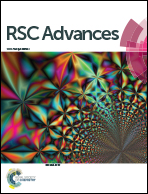Adsorption–reduction of chromium(vi) from aqueous solution by phenol–formaldehyde resin microspheres
Abstract
A novel adsorbent of phenol–formaldehyde resin (PF) microspheres was prepared at a low temperature, and had an excellent performance for the adsorption–reduction of Cr(VI). The microspheres were characterized by transmission electron microscope (TEM), scanning electron microscopy (SEM), Fourier transform infrared spectroscopy (FTIR), thermogravimetric analysis (TGA), X-ray photoelectron spectroscopy (XPS) and energy dispersive spectrometer (EDS). The effects of contact time, pH value and initial concentration, adsorbent dosage and temperature were studied by batch mode. The results showed that the adsorption process fitted a pseudo-second-order model and a Langmuir isotherm model very well, and an intra-particle diffusion model gave three stages in the whole process. Thermodynamic constant values (ΔH° > 0, ΔS° > 0, ΔG° < 0) indicated that the adsorption process was endothermic and spontaneous. The maximum adsorption capacity of Cr(VI) on the adsorbent reached 280.9 mg g−1 at 303 K. The PF microspheres could be applied to Cr(VI)–water treatment with the reduction and adsorption of the heavy metal ion.


 Please wait while we load your content...
Please wait while we load your content...